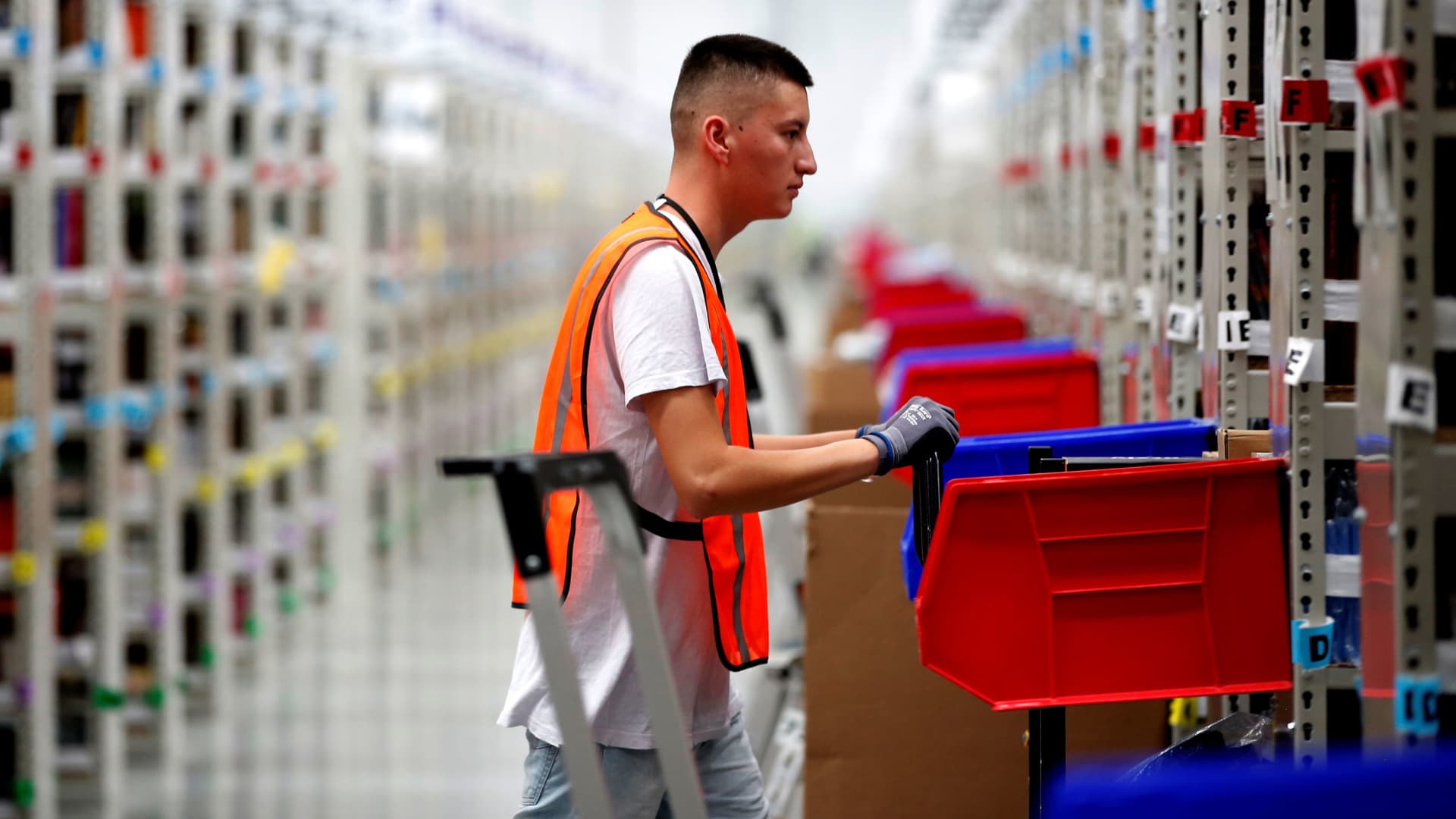

An employee looks for items in one of the corridors at an Amazon warehouse.
Carlos Jasso | Reuters
Amazon warehouse workers are suffering physical injuries and mental stress on the job as a result of the company’s extreme focus on speed and pervasive surveillance, according to a new study.
The study, released Wednesday by the University of Illinois Chicago’s Center for Urban Economic Development, includes responses from 1,484 current Amazon workers across 42 states and 451 facilities, in what the authors are calling the largest nationwide survey of Amazon workers to date.
Nearly 70% of Amazon employees who participated in the survey said they’ve had to take unpaid time off due to pain or exhaustion suffered on the job in the past month, while 34% have had to do so three or more times. The most common injury reported by workers was sprains, strains or tears, and nearly half of respondents said they had moderate or severe pain in the leg, knee or foot in the last three months on the job. More than half of workers said they’re burned out from their work at the company, and that response rate intensified the longer the employee had worked at Amazon.
The data adds to a drumbeat of scrutiny around Amazon’s workplace safety and treatment of warehouse employees. Regulators, lawmakers, rights groups and employees have criticized Amazon — which is the second-largest employer in the U.S., behind Walmart — over its labor record. The researchers estimate Amazon is the largest warehouse employer in the country, accounting for an estimated 29% of workers in the industry.
Amazon had roughly 1.46 million employees globally, as of the quarter ended June 30, and the majority are warehouse and delivery workers.
The Occupational Safety and Health Administration and the U.S. Attorney’s Office are investigating conditions at several warehouses, while the U.S. Department of Justice is examining whether Amazon underreports injuries. In June, a Senate committee led by Sen. Bernie Sanders, I-Vt., also launched a probe into Amazon’s warehouse safety.
Amazon has said it has made progress on lowering injury rates and that the company has made adjustments to working environments in order to reduce strain and repetitive movements. It has begun to automate some tasks and is also rolling out more robotic systems in warehouse facilities that the company claims can improve safety, although that prospect has been debated.
About 64% of workers who participated in the survey said they feel the safety of workers is a high priority at Amazon, but that sentiment is lower among those who reported negative impacts to their physical health from the job.
Workers fulfill orders at an Amazon fulfillment center on Prime Day in Melville, New York, US, on Tuesday, July 11, 2023.
Johnny Milano | Bloomberg | Getty Images
Role of speed and surveillance
Safety critics have increasingly zeroed in on Amazon’s speedy pace of work and close monitoring of employee productivity as factors that lead to a heightened risk of injuries.
The survey results underscored that point, finding that those who reported injuries on the job while working at Amazon are more likely to say that keeping up is hard than workers who have not been injured.
Approximately 44% of workers surveyed said they couldn’t take breaks when they need to, according to the study. “A key mechanism for workers to maintain a fast pace of work without injury is the ability to take breaks and recover from periods of intense work,” the researchers said.
Employees pointed to “technology-enabled workplace monitoring” as something that reinforces the pace of work, while 53% of respondents said they always or most of the time “feel a sense of being watched or monitored in their work at the company.”
“We see clear evidence in our data that work intensity and monitoring contribute to negative health outcomes,” the researchers said.
Amazon uses a variety of metrics to measure warehouse workers’ activity on the job, the researchers said, including rate, or the number of tasks they’re expected to complete per hour; task time, which measures the average time between scans with a barcode scanner; and idle time, or “time off task,” which measures time a worker isn’t scanning items while on the clock.
Workers have argued that the time off task policy makes working conditions more strenuous and that it’s used as a tool to surveil workers. Amazon in 2021 adjusted its time off task policy so that it averages data over a longer period.
WATCH: Amazon’s worker safety hazards come under fire from regulators and the DOJ




